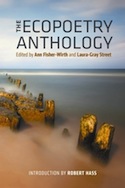As the critic R. P. Blackmur said, poetry “adds to the stock of available reality.” In The Ecopoetry Anthology, editors Ann Fisher-Wirth and Laura-Gray Street present hundreds of poems that add to our reality about the natural world, its beauties and its degradations. This groundbreaking collection has the capacity to transform people’s lives aesthetically and politically. Poetry’s eloquent and ineffable power can work to enhance our understanding of the world beyond the human and lead us to act with more respect, humility, and stewardship toward the environment.
The poets collected here, of wide-ranging talents, backgrounds, and beliefs, speak in many voices to reinforce the most critical story of our time: that we must love and care for the planet and appreciate the integrated biological beauty that sustains us, or lose the only world we’ve got.
Shelf Awareness, Feb 11, 2013
Review: The Ecopoetry Anthology
The Ecopoetry Anthology by Ann Fisher-Wirth and Laura-Gray Street, editors (Trinity University Press, $24.95 paperback, 9781595341464, February 12, 2013)
What drew us to the magnet of your dying?…
Voyager, chief of the pelagic world,…
Master of the whale-roads,
let the white wings of the gulls
spread out their cover.|
You have become like us,
disgraced and mortal.
These powerful lines are from Stanley Kunitz’s “The Wellfleet Whale,” one of the many poems in Ann Fisher-Wirth and Laura-Gray Street’s rich and generous The Ecopoetry Anthology. Nature poetry has been around as long as poetry, Fisher-Wirth and Gray tell us, but, sometime around 1960, more people began to pay attention to an environment and nature in crisis–and poetry began to reflect this renewed attention.
“Poetry does not tamper with the world,” as William Carlos Williams wrote, “but moves it.” So here is an abundance of poems–praising songs, incantations, lists, elegies, rhapsodies, jeremiads–each in their very different ways bearing the power “to break through our dulled disregard, our carelessness, our despair, reawakening our sense of the vitality and beauty of nature.” All told, 320 poems by 208 poets–abundance indeed.
Part one presents poets, from Walt Whitman to Denise Levertov, who predate the environmental revolution. Next come 176 contemporaries, from A.R. Ammons to Robert Wrigley. It’s apropos that the first poem in this middle section is Ammons’s seminal piece, “Corson’s Inlet,” where he observes nature as he walks along his Jersey Shore dunes: “in nature there are few sharp lines: there are areas of/ primrose/ more or less dispersed.”
Fisher-Wirth and Gray have done a superb job of providing works by both well-known and lesser known poets. Alongside such luminaries as W.S. Merwin, Gary Snyder and Mary Oliver, one can discover beautiful and moving pieces by Patrick Lawler, Davis McCombs or Annie Boutelle. Some readers may be disappointed at the absence of a favorite poem, but most of the “great” nature pieces of the modern era are here, including Galway Kinnell’s overwhelming “The Bear,” Robert Bly’s moving prose poem “The Dead Seal” and Robert Hass’s mini-epic, “State of the Planet.” Hass also provides a wise introduction, noting that The Ecopoetry Anthology reveals the ways our “nature poetry developed toward an ecopoetics, toward the necessity of imagining a livable earth.” –Tom Lavoie
Shelf Talker: Here is bounty indeed–an innovative anthology drawing upon 150 years of American poetry about nature, animals and our precious environment.
